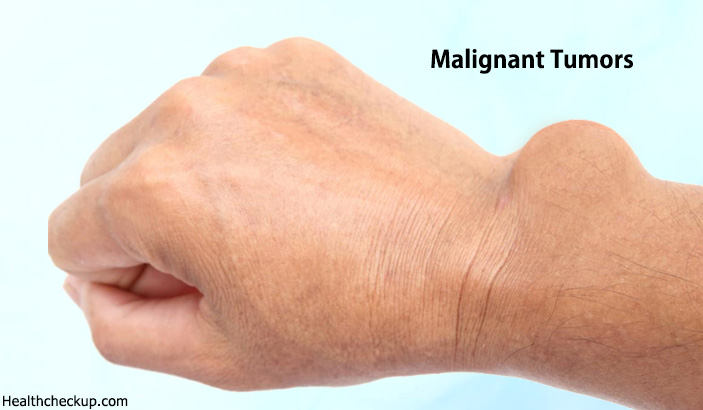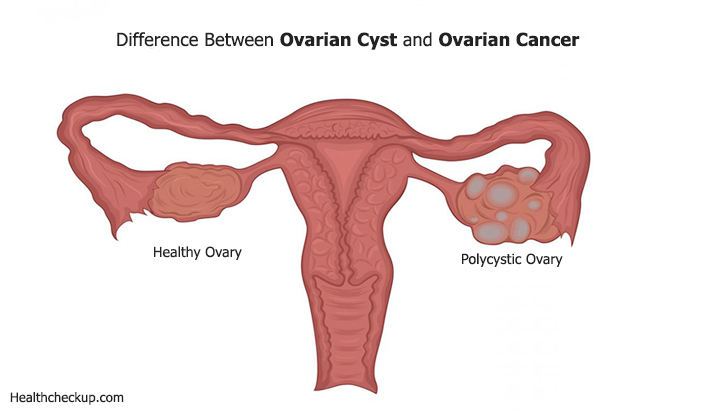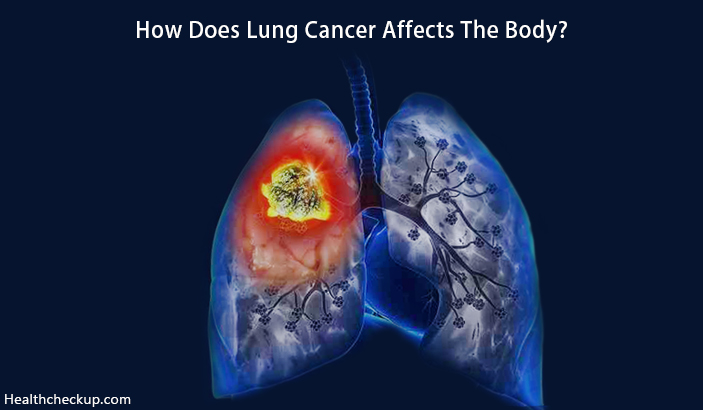The word “Tumor” means an overgrowth of an abnormal tissue mass. This over-growth is unrelated or not in coordination with the growth and development of rest of the body. In medicine, the term “Neoplasia” is used to address a tumor – “Neo” meaning New and “Plasia” meaning Formation.
Just like parasites, which draw nutrition from its host, tumors also grow at some part of the body and cause wasting of tissues of the affected person. Also, tumors tend to increase in size irrespective of their location or neighbouring structures.
Tumors are differentiated into two types depending upon their growth, spread, clinical and microscopic features
| Features | Benign Tumors | Malignant Tumors |
|---|---|---|
| Boundaries | Encapsulated or well circumscribed | Irregular and poorly circumscribed |
| Surround tissues | Tumor expands and pushes or compresses the surrounding tissues without invading them | Invades and destructs the surrounding tissues |
| Size | Usually small | Usually larger |
| Shape | Generally spherical or oval | Irregular shape |
| Pattern | Closely resembles original tissue and is well-differentiated | Poorly resembles original tissue and is poorly-differentiated |
| Growth rate | Usually slow | Usually rapid |
| Metastasis (spread to other sites) | Absent | Frequently present |
| Prognosis | Local complications due to tumor | Death due to local and metastatic complications |
It is quite clear from the table above that benign tumors are relatively harmless and be removed surgically. They do not invade or destroy the adjacent tissues.
Malignant tumors, on the other hand, tend to destroy and spread to other tissues. They tend to form secondary tumors at other sites. This process of infiltration to other sites is called “Metastasis”.
Routes by Which Malignant Tumor Metastasize are
1. Lymphatic system
2. Blood circulation
3. Spread along body cavities like peritoneum, cerebrospinal fluid
Grading and Staging of Cancer
Grading of cancer is based on two features are a degree of differentiation and rate of growth. Grading is the microscopic and macroscopic/gross degree of differentiation of a malignant tumor. Based on this, Border’s grading for cancer is
➢ Grade-I – Well differentiated (less than 25% anaplastic cells), least malignant.
➢ Grade-II – Moderately differentiated (25-50% anaplastic cells)
➢ Grade-III – Moderately differentiated (50-75% anaplastic cells)
➢ Grade-IV – Poorly differentiated (more than 75% anaplastic cells). Most malignant.
Staging measures Extent of Spread of A Malignant Tumor. Two Methods for Staging are Used
➢ TNM staging – T-primary tumor, N-regional nodal involvement and M-distant metastasis.
➢ AJC staging – the American Joint Committee staging divides cancer from stage 0-IV taking into account primary tumor, nodal involvement and metastasis.
Survival of Patients having Malignant Tumors Depends upon Factors
- Size of malignant tumor
- Grade of tumor
- Vascular invasion
- Lymph node involvement
- Cancer Markers – These tumor cell markers are different for different types of cancers.
Causes For Malignant Tumors
Cancer has emerged to be a major health concern owing partially to non-modifiable factors like genetics and modifiable factors like eating habits, cigarette smoking, substance abuse, sedentary lifestyle, physical inactivity and an un-ending amount of stress.
| Non Modifiable Factors | Modifiable Factors |
| Family History – about 5% of all cancers have a strong correlation with family history.
Ex: ● Retinoblastoma-about 40% patients have a family history of the same. ● Multiple endocrine neoplasia ● Breast cancer-daughters or close female relatives of a breast cancer patient have a 3-fold risk of developing breast cancer. ● Neurofibromatosis I and II
Racial and Geographic factors: ● Cancer of lung, breast and colon are common among Europeans and Americans ● Cancer of skin, liver, penis and cervix are common among Africans ● Cancer of stomach is commonly seen among Japanese people ● Cancer of breast, liver, cervix, oral cavity is common among Indians.
Sex – some tumors have affinity to certain genders Ex: Lung cancer is seen more commonly in men than in women.
Infection – oncogenic viruses can invade the body via viral infection with: ● Human T-cell Leukemia Lymphoma Virus type-I (HTLLV) ● Human Papilloma Virus (HPV) ● Epstein-Barr Virus (EBV) ● Hepatitis-B Virus (HBV)
Exposure to ionizing radiation as a part of treatment for some other type of cancer. |
Cigarette smoking – Associated with cancer of oral cavity, pharynx, larynx and lungs
Alcohol Abuse – Linked to cancer of stomach, esophagus, liver and urinary tract.
Cancer of cervix is related to multiple partners, age at first coition and unprotected coition.
Chewing Tobacco – Related to cancer of cheek and tongue
Occupational exposure – To carcinogenic agents like: ● Benzene ● Asbestos ● Lead ● Vinyl chloride ● Exposure to radiation, etc.
Dietary habits – Low quality diet like junk and fried food and less intake of fruits and vegetables are linked to less intake of anti-oxidants
Obesity – Overweight individuals have a high risk of developing colon cancer due to high fats and less fiber content in diet.
|
Signs and Symptoms of Malignant Tumors
Clinical features of malignant tumors will be seen both, because of local effects of that tumor and certain systemic effects since it invades other structures as well.
| Local effects | Systemic effects |
| Obstruction or pressure on flow of blood or other fluids like bile or cerebrospinal fluid.
Bleeding or ulceration is commonly seen in gastric, colonic and renal cell carcinomas
Infection of organs due to obstruction such as pneumonia and urinary tract infection
Rupture of a malignant tumor – cancers of ovary, bladder and colon tend to rupture
|
Fatigue – because of loss of muscle function and occasionally sleep disturbances.
Anemia from bleeding, cytotoxic drugs, radiation and involvement of bone marrow.
Cachexia – constitutional symptoms like weight loss, fever, loss of appetite and progressive weakness
Paraneoplastic syndrome – certain malignant tumors start to release hormones Ex: ● Hypoglycemia due to insulin like substance secreted by a fibrosarcoma ● Secretion of parathyroid like hormone from a colorectal adenocarcinoma |
Diagnosis of Malignant Tumors
Timely diagnosis and detection of a malignant tumor is extremely important to mange and eliminate the tumor and its arrest its progress at an early stage. Most commonly used diagnostic techniques for malignant tumors are
- Histology – Histology orMicroscopic examination of a tumor mass with the help of a biopsy. This is the most valuable and the most reliable method to diagnose if the tumor is benign or malignant and even for staging the cancer.
- Cytology – fine needle aspiration cytology (FNAC) collects samples of a lesion to be examined under a microscope. The procedure is less painful as compared to a biopsy.
- Histo-chemistry and Cytochemistry – This method is an additional tool to help in understanding the chemical composition of cells by using various staining methods.
- Electron Microscopy – This ultra-structural microscopy helps to understand the structure of tumor cells and their components for diagnostic purpose.
- Tumor Markers – Tumor markers are biochemical assays of products secreted by a malignant tumor. Tumor markers support a diagnosis and they also help in prognosis.
Example of certain tumor markers:
● Alpha-feto protein – hepatocellular carcinoma
● Prostate Specific Antigen (PSA) – Prostate Cancer
● CA-125 – Ovarian Cancer
● CA-15-3 – Breast Cancer - Flow Cytometry – This is a computerized technique to understand characteristics of tumor cells in detail and to store data for subsequent comparison.
Treatment of Malignant Tumors
Treatment and management of malignant tumors depends entirely on their growth and spread. Some treatment options available are:
- Surgery – Surgery woks for tumors that are confined to a single location. Surgery cannot be used as a treatment plan for tumors which have spread to other organs.
Surgery can remove a localized tumor and even ease symptoms caused by pressure of that tumor. - Radiation therapy – High doses of radiation are used to kill cancer cells and shrink tumors. Radiation also affects healthy cells which is a major side effect.
Internal radiation therapy is often used to treat cancers of thyroid, head and neck, prostate, cervix, breast and eye.
Radiation therapy is usually given along with surgery and chemotherapy. - Chemotherapy – This therapy is used to destroy cancer cells and easy symptoms of cancer. Chemotherapy can be given orally, subcutaneously or intravenously. It can also be injected into the muscles of arms or thighs.
- Immunotherapy – This therapy uses substances made out of living organisms to treat malignant tumors.
Immunotherapy enhances the body’s immune system to fight against cancer. It is less commonly used as compared to surgery, chemotherapy and radiation therapy. Immunotherapy has side effects like flu-like symptoms, nausea and vomiting, fatigue, pain, and swelling, soreness, rash and itching. - Target therapy – This therapy has a pre-requisite of biopsy of the malignant tumor. This therapy destroys cancer cells and stops cancer cells from growing. It also boosts immunity and prevents formation of new blood vessels (angiogenesis) within the tumors. Without blood vessels, the tumor does not grow in size or shrinks.
- Hormone therapy – This therapy slows down the growth of cancer which uses hormones to grow. Hormone therapy is commonly used to treat prostate cancer and breast cancer. Side effects include hot flashes, weakness of bones, nausea, and fatigue and mood changes.
- Stem cell transplant – In this therapy healthy blood-forming stem cells are administered intravenously. These stem cells travel to the bone marrow and take place of the cells that were destroyed previously by radiation or chemotherapy. This therapy is commonly used for leukemia, lymphoma and sometimes for multiple myeloma and neuroblastoma.
Natural Remedies for Malignant Tumors
Usually malignant tumors are diagnosed at much later stage when signs and symptoms become alarming. Therefore, it is impossible to treat cancer without the help of the above mentioned treatment strategies.
However, certain natural remedies can be taken to not just attempt to treat malignant tumors naturally, but also to prevent the risk of having cancer.
- A lot of studies have been done to study the role of a ketogenic diet along with hyperbaric oxygen chamber therapy.
- Ketogenic diet enhances the body’s ability to convert fats into sources of energy.
- Cancer cells live due to energy created by fermentation of glucose. Ketogenic diet reduces the energy generated by breakdown of glucose.
- Following ketogenic diet regularly has known to increase survival rate of cancer patients by about 50%.
- Vegetables and fruits low in carbohydrates are rich in anti-oxidants and they eliminate free radicals from circulation
- Combining ketogenic diet and hyperbaric oxygen therapy has results in reducing growth of tumors and reduce glucose levels which serve as a source of energy for tumor cells.
- Fresh Fruits and Vegetables – Sulforaphane found in cruciferous vegetables reduces carcinogens from cells and tissues. Quercetin found in vegetables, broccoli, red onion, pepper, grapes, green tea, black tea and red wine is known to prevent cancer metastasis.

- Fermented Vegetables – Harmful bacteria in the gut are responsible for several illnesses, metabolic conditions and cancers of colon, rectum, pancreas and gall-bladder. Fermented vegetables and food help in maintaining healthy gut flow which in return maintains overall health.
- Vitamin D – This vitamin is widely used for management of lymphomas and cancers of bladder, ovaries, head and neck. Vitamin D promotes functioning of GcMAF (Glycoprotein Macrophage Activating Factor) which is known to regulate cancer cells and reverse breast cancer.
- Turmeric – This kitchen herb has anti-inflammatory properties and a strong ability to fight against infections and cancer cells.

- Budwig’s Protocol – Dr. Johanna Budwig discovered this mixture. A combination of soft, fresh cheese (quark) and 1 tablespoon of flaxseed oil or ground flax seeds was the Budwig protocol.
Flaxseed oil in quark is rich in electrons and saturated fats. Quark protects the electrons within the flaxseed oil so that it can charge dead cells. This mixture provides energy to such cells and makes the healthy. These healthy cells then fight against cancer cells. - Detoxification with the help of plenty of water, infrared saunas (for deep tissue stimulation), castor oil packs, dry brushing (for flow of lymphatics) help in flushing out toxins from the body.
- Sunlight – getting adequate amount of sun exposure is important to stimulate glands of our body like the pancreas, liver, gall bladder and salivary glands. Sunlight not only stimulates glands to maintain health, but also removes toxins from the body.

- Beta-glucans – This is a soluble fiber, having a good role in lowering cholesterol. In cancer patients, beta-glucans activate immune cells like Natural killer cells, T-cells and macrophages to act against tumor cells. Beta-glucans also help in treating auto-immune diseases. Foods rich in beta-glucans are oatmeal, barley and mushrooms.
- Herbal Remedies – Chinese herbal remedies including acupuncture, cupping, and massage therapy and so on are useful in order to avoid side effects of modern treatment methods.
None of these above remedies are meant to substitute conventional treatment of malignant tumors. Also, certain herbs may react adversely with your regular medications and so it is important to consult your physician or oncologist before taking any herbal medicines.
Medically Reviewed By
Dr. Himanshi is a Homoeopathic consultant and currently working as a lecturer in Post-graduate faculty of Homeopathy, Parul University, Vadodara. Completed BHMS and MD in Homeopathy in January 2018 and also has a clinical experience of about 6 years. Personal interests include reading, spending time with family and traveling.











